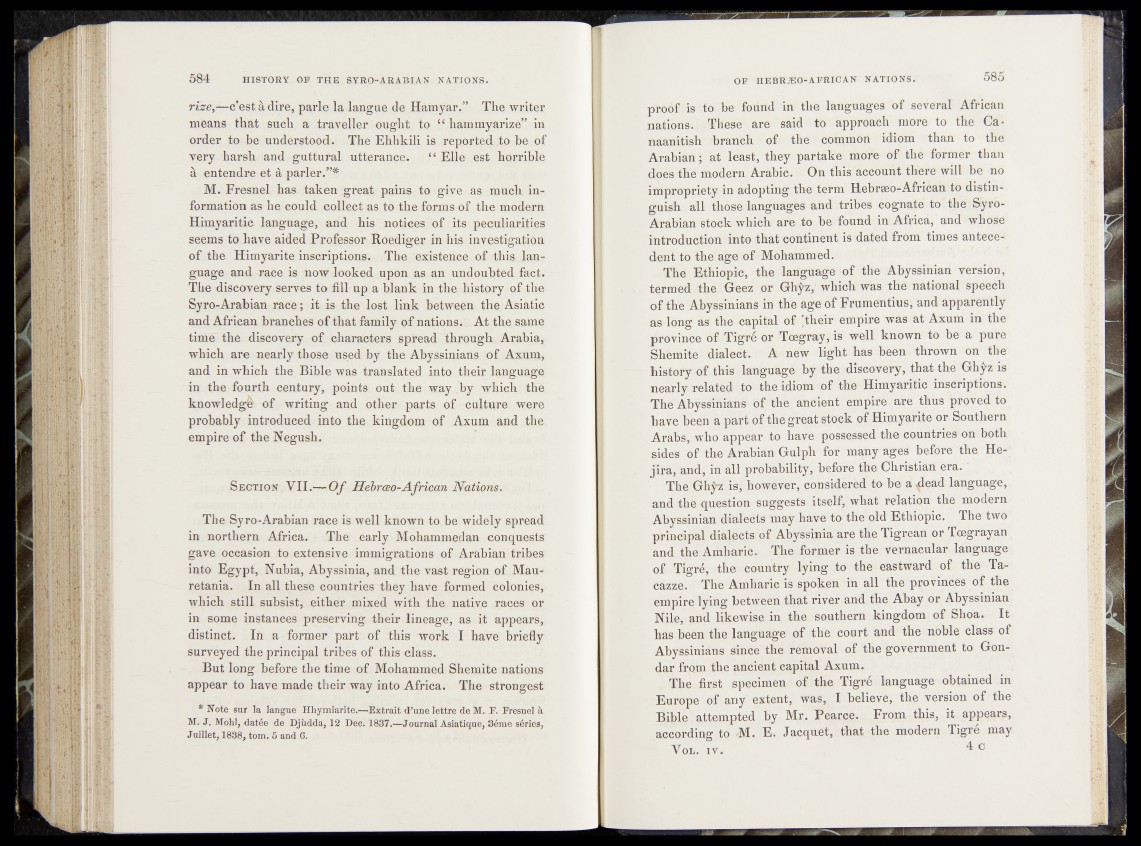
rizei—c’estji dire, parle la langue de Hainyar.” The writer
means that such. a traveller ought to “ hammyarize” in
order to be understood. The Ehhkili is reported to hfi of
very harsh and guttural utterance. “ Elle est horrible
a entendre et 4 parler.”#
M. Fresnel has taken great pains to give as much information
as he eould collect as to the forms of the modern
Himyaritic language, and his notices of its peculiarities
seems to have aided Professor Roediger in his investigation
of the Himyarite inscriptions. The existence of this language
and -race is now looked upon as an undoubted fact.
The discovery serves to fill up a blank in the history of the
Syro-Arabian race; it is the lost link between the Asiatic
and African branches of that family of nations. At the same
time the discovery of characters spread through. Arabia,
which are nearly those used by the Abyssinians of Axum,
and in which the Bible was translated into their language
in the fourth century, points out the way .by! wlpelx the
knowledge1 of writing and other parts of -culture were
probably introduced into the kingdom of Axum and the
empire of the Negush.
S e c t io n VII.—Of Hebrceo-Africcm Nations,
The Syro-Arabian race is well known éfebewidely spread
in northern Africa. The early Mohammedan conquests'
gave occasion to extensive immigrations of Arabian tribes
into Egypt, Nubia, Abyssinia, and the vast region of Mauretania.
In all these countries they have formed colonies,
which still subsist, either mixed with the native races or
in some instances preserving their lineage, as it appears,
distinct. In a former part of this work I have briefly
surveyed the principal tribes of this class.
But long before the time-of Mohammed Shemite nations
appear to have made their way into Africa. The strongest
* Note sur la langue Hhymiarite.—Extrait d’une lettre de M. F. Fresnel à
M. J. Mohl, datée de Djùdda, 12 Dec. 1837.-—Journal Asiatique, Sème séries,
Juillet, 1838, tom. 5 and 8. -
proof -is to be found in the languages of several African
nations. These are said to approach more to the Ca*
naanitish branch of the common idiom than to the
Arabian ; at least, they partake more of the former than
does the modern Arabic. On this account there will, be no
impropriety .in adopting the term Hebrseo-African to distinguish
all those languages and tribes cognate to the : Sy ro-
Arabian stock which are to be; found .in: Africa, and whose
introduction into (that continent' is dated from times anteced
e n t^ ’ the'age of Mohammed.
The Ethiopie, the language^! the Abyssinian version,
termedilfhê iGeez of Ghyz,' which was the national speech
of the Abyssinians in the age of Frumehtium and apparently
as long as the-capital of ’their empire was at Axum in the
province óf Tigré or Toegray, is well known to be a pure
Shemite dialect. A new light has been thrown on the
history of this language by thq discovery, that the Ghÿz is
nearly related« to the, idiom * of the Himyaritic inscriptions.
The Abyssinians of the ancient empire are thus proved to
have been a part of the great itock of Himyarite or Southern
Arabs, who appear to have possessed the countries on both
sides of the Arabian Gulph for many ages before the Hejira,
and, in all probability, before the Christian era. ,
Thé Ghÿz is, however, considered to bô a^ead language,
and the question suggests itself, what relation the modern
Abyssinian dialects may havé to the old Ethiopie. The two
principal dialects of Abyssinia are the Tigrean or Toegray an
and the Amharic. The former is the vernacular language
of Tigré, the country lying to the eastward of the Ta-
cazze. The Amharic is spoken in all the provinces of the
empire lying between that river and the Abay or Abyssinian
Nile, and likewise in; the southern kingdom of Shoa. It
has been the language of the court and the noble class of
Abyssinians since the removal of the government to Gon-
dar from the ancient capital Axum.
The first specimen of the Tigré language obtained in
Europe of any extent, was, I believe, the version of the
Bible . attempted by Mr. Rearce. From-this, it appears,
according to <M. E. Jacquet, that the modern Tigré may
Vol. iv. I * 4 c